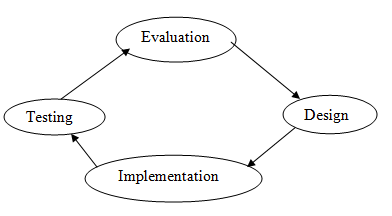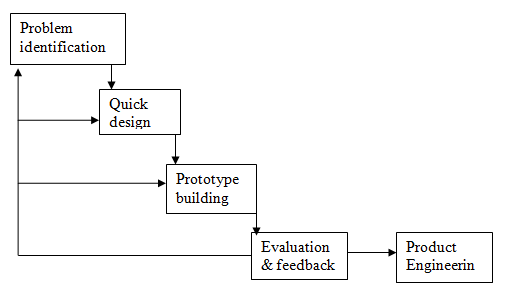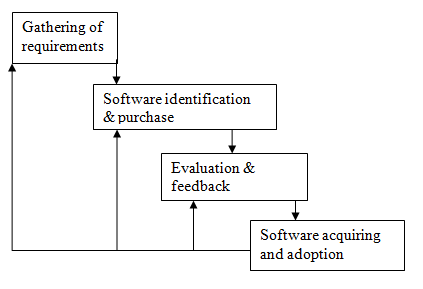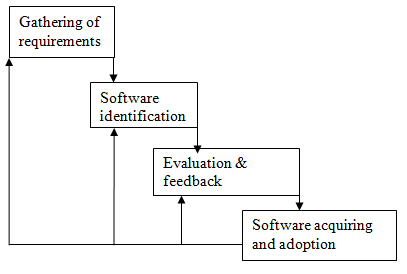Introduction
In the recent years, there has been emphasis on business approaches. The idea has highlighted need for a mechanism to elicit, represent and validate the requirements that would focus on co-development activities that aim at enhancing alignment between support technical systems and business processes (Vasilecas, 1983).
After several studies and researches, experts and scholars brought the idea of systems development as a solution to the business problem. In systems development, the key challenge encountered during domain experts’ engagement is to articulate, agree and validate the systems.
The challenge is usually common in the early requirements’ phase where multiple parties from different organization’s divisions need to come to a consensus of the intended systems (Vacilecas, 1983). Decisions made at this level should focus on the effects of the economic and technical feasibility of the project.
The professionals in information systems should not only focus on the functionality and non-functionality of the intended systems but should also focus on the organizational needs and contexts (Vacilecas, 1983). In the development of the information systems, the first stage is to describe and model the real problem that provides the need for the system. The modelling process gives way to facilitate the analyst-client communication.
This process is therefore mainly used to bring the analyst and stockholders on the agreement of the intended systems as agreed during their engagements.
This paper examines information systems, enterprise resource planning, different information systems, development approaches or methods and their illustration with diagrams, the intended retail industry with clarification of the reasons for the industry and finally the conclusion of the report (Vacilecas, 1983).
Information Systems
An information system is a combination of integrated information technology and people, who support, manage and make decisions (Reynolds & Stair, 2011). Its purpose is to enhance communication or interactions between people, data, technology and process. The term does not, therefore, refer to software and technology used in communication in an organization but also includes people who interact and support the technology.
In business, an information system mainly focuses on the end use of the information technology (Lang, Wojtkowski, & Wojtkowski, 2009). It, therefore, serves the end users in a business. It works to process information in a business through capturing, storing, transmitting, manipulating, retrieving and displaying information. The system thus acts to inter-relate data and activity systems.
Information system consists of computers, people, procedures/instructions, and stored facts. The IS may be categorized into four parts depending on the intended purpose. These categories are the management information systems, transaction-processing systems, executive information systems and decision support system (Lang, Wojtkowski & Wojtkowski, 2009).
Enterprise Resource Planning
An enterprise resource planning is a system that integrates the internal and external business or organizational information (Reynolds & Stair, 2011). It interconnects all the divisions of an organization and the external sources of information to the business or organization. In an organization, the enterprise planning system interconnects the finance department, human resource department and operations.
In addition, the ERP systems also ensure that there is an interconnection in a certain department (Reynolds & Stair, 2011). On other hand, the enterprise resource planning facilitates the communication between the business and its stakeholders. It runs on a variety of network and hardware configurations that employ database as a storage for the information.
The enterprise resource planning system has the following characteristics: it operates in real time through integrated system that do not rely on a periodic updates, supports all applications by use of a common database, a consistent look and simple installations of the systems.
The installation of enterprise resource planning system does not require elaborate information technology department, as application and data integration are usually simple. It comprises the transaction database, management portal, external access, management of documents, messaging, and management of workflow, search, report customization and business intelligence system (Reynolds & Stair, 2011).
Information System (IS) Development Methods/Approaches
The information system methodology refers to framework used in the development of the systems. System development starts with understanding and analyzing the problem (Lang, Wojtkowski & Wojtkowski, 2009). This gives the idea of the system required to solve the problem.
In system development, both the stakeholders and the system analysis engage in several instances to articulate, agree and validate the problems of the business and further make a decision of the system to be used (Vacilecas, 1983). During these approaches, they involve a specialist who gives them advice and guidelines that are required to solve their problem and the most appropriate system to their problems.
However, after the identification of the problem and requirements’ specifications, development of the system follows, which may be done in various approaches. These approaches include:
System Development Life Cycle
The software development life cycle is a process that involves phases, the first phase being the analysis. The aim of the analysis is to identify the problem that needs a system.
It starts by bringing drown the system into various situation analysis that focuses on the problem, goal analysis that evaluates the objectives set for the system, user analysis that defines the requirements of the user from the system and need analysis that evaluates and defines the needs of the system.
In requirement analysis, the client’s team and provider should give detail and accurate specifications in order to elaborate on the requirements (Newcomb & Ulrich, 2010). The second phase is design, which involves intensive functions and operations that describe the details of the requirements. The phase documents requirement is to have a clear understanding of the business layouts, rules and process diagrams.
Further, in this phase the developers describe the desired features of the systems in sufficient detail in respect to the requirements from the user. This stage fully describes the new system to apply (Lang, Wojtkowski & Wojtkowski, 2009). The third phase is on implementation where after the system design, the real code of the system is written. The developer takes systematic instruction procedure from the design phase to write a code.
The fourth phase is on testing where at this stage, the software is brought to the real environment (Reynolds & Stair, 2011). The software is installed and tested to assert its functionality where the code of the software is tested on various levels to ensure that the software meets all the requirements of the business. The testing of defect, system integration, user acceptance, automation and performance take place at this very stage.
If the software test is successful, the software goes to the final stage of its evaluation. At this phase the software is now already present in the information system. Evaluation of the system serves to the purpose of solving various business problems (Reynolds & Stair, 2011). If it succeeds then the business adopts and maintains the system.

Prototyping
In prototyping, the initial stage is finding the problem that makes the business require a system (Newcomb & Ulrich, 2010). After realizing and analysis of the problem, the developer comes up with the initial software that is brought to the real environment. The system is then usually released to the user who interacts with it to provide the feedback on the system.
After the feedback, the developer analyzes it so that he/she could incorporate the requirements into the feedback in engineering the second version (Newcomb & Ulrich, 2010). The second version then follows the same process of evaluation until the system meets the expected requirements and performance.

Application Software Package
Application software refers to software that has been in use in business for several decades. The software is meant for commercial purposes and the client can acquire them from the developers at certain costs. This solves the business problems without developing internal software for the business (Lang, Wojtkowski & Wojtkowski, 2009).
In this approach, the initial stage turns out to be problem identification in the business and its analysis accordingly. After the analysis, the business parties, owners and the stakeholder, give their requirements on the system to adopt to solve their problems. The software analyst or experts after it do analysis of the requirements and evaluate them to find the best software in the market that can meet the needs.
The analyst advises the business on the best software that meets their requirements and problem (Lang, Wojtkowski & Wojtkowski, 2009). He/she purchases the software on behalf of the business that they bring to test and give feedback.
If the software does not meet the requirements and performance, the users give the feedback, for an adoption of the second software. The process repeats until the software is adopted that meets the required performance and specifications (Lang, Wojtkowski & Wojtkowski, 2009).

End User Software Development
In this model, after the identification of the problem, the stakeholders discuss the requirements of the system intended to solve the problem. The role of designing the software passes to users who develop the system intended. The end users analyze the requirements and the specifications of the required system, so that they can start the design.
After design, the end user writes the real code using fourth generation software tools (4GL) (Newcomb & Ulrich, 2010). After that, the written software proceeds to the next stage, the evaluation stage. If the software meets the requirements, functionality and specification required by the business is sustained otherwise it goes back to the previous stages until it meets the required specifications.

Outsourcing of the Software
In this approach, an enterprise identifies its problems and specifies its requirements that are absorbed by a software consultant. After the evaluation of the problems and requirements, the consultant does an investigation of a vendor who experienced the same problem in the past and had the same and similar software requirements.
He/she advises the enterprise to buy software and evaluate its performance to meet the system specification. If the software meets the specification, then the company fully adopts the system, otherwise it goes to the consultant to identify alternative software until they find software that meets their specifications (Lang, Wojtkowski & Wojtkowski 2009).

Retail Industry
Retail industry refers to an economic sector owned by individuals and/or companies that deal in distribution and selling of finished products to consumers (Segel, 2008). The business owners must interact with their consumers who are the end-users, store, record and retrieve data and they thus need an information system. The best option in the retail industry would be the pharmaceutical sub retail.
Several pharmaceuticals all over the world use information system software. This gives a benefit of having software for adoption by the enterprise. In addition, there are several consultants and software developers in the field of pharmaceutical that will expose me to various and numerous skills, experience as well as competence.
Further more, pharmaceutical industry does not require complicated systems that will give an advantage in development of the systems. Pharmaceuticals, on the other hand, do not require many stakeholders during their decision-making. This enhances quick agreement on requirements that make it simple to deal with the industry (Segel, 2008).
It further gives a benefit of not so many end-users using the information systems that make it simple in the evaluation and testing of the systems. In system development the main challenge is the agreement on the requirement and in the pharmaceutical industry agreement, the challenges are simply solved out.
Further, the existence of software in market that is applicable in the industry gives several approaches to put in place during the development of the software. This gives an advantage of having software that has been in operation that gives in its turn an assurance of sustenance in the enterprise.
In addition, in the pharmaceutical, the availability of fewer end-users that use the system gives a benefit of the systems which do not develop major problems and this makes the work as a consultant, less demanding.
Approach Chosen
As a consultant, I would like to choose to use outsourcing of the software as my approach to enterprise system development. Currently, there are several enterprises with the same kind of operations almost in every field. The use of the approach would save me as a consultant time spent in the coding of the design into software.
Outsourcing as an approach exposes me to several software in use in the field of my enterprise that would help me in making the right choice. This is according to the relationship between the problem to be solved and the problems solved by the software in the firm from which the software is being sourced.
Further, the application of the software by the other vendor who is the owner gives me an opportunity to interact with the software in its application by the vendor to find out whether it meets the requirements and specification to solve the problems associated with the adopting enterprise or not
Conclusion
To sum it up, it should be highlighted that the Information system is important to any enterprise whether it is large or small. The IS functionality in the right manner gives an enterprise the ability to meet its functions and goals. Any business must store data, and communicate with its end user.
The approach used during system development should, therefore, be in a position to help an enterprise to acquire an information system that meets its specifications. This gives the enterprise the ability to meet its goals. Thus, it is important for any enterprise to choose the right methodology while acquiring the IS.
References
Lang, M., Wojtkowski, G. & Wojtkowski, W. (2009). Information systems development: challenges in practice, theory and education. New York: Springer Science Business Media, LLC.
Newcomb, P., & Ulrich, W. (2010). Information systems transformation: Architecture-driven modernization case. Burlington: Morgan Kaufmann Publishers.
Reynolds, G. & Stair, R. (2011) Principles of information systems. Boston: Cengage Learning.
Segel, R. (2008). Retail business kit for dummies. Indiana: Wiley Publishing Inc.
Vasilecas, O. (2005). Information systems development: advances in theory, practice and education. New York: Springer Science Business Media, LLC.